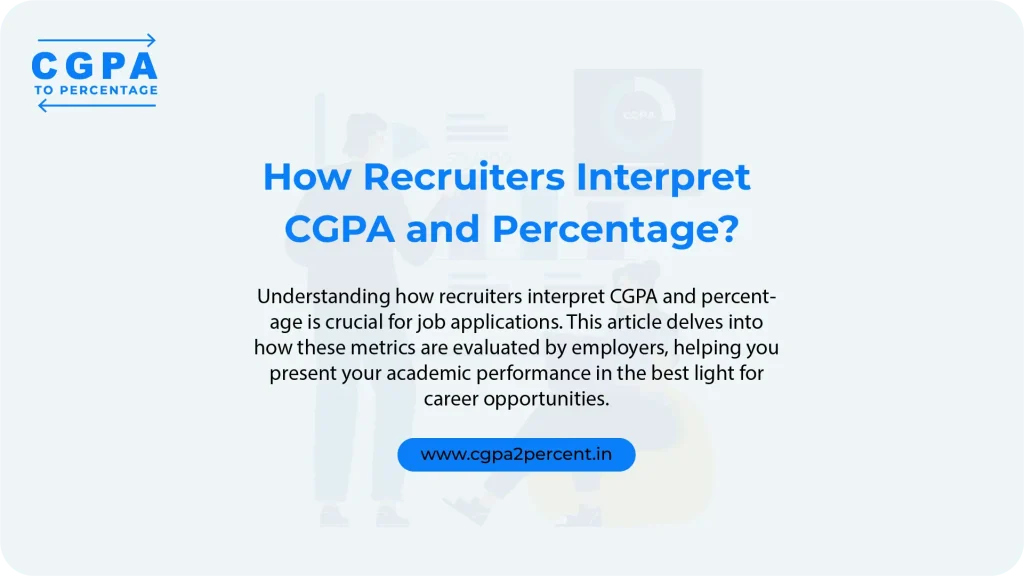How Recruiters Interpret CGPA and Percentage
Students often get confused when applying for the jobs. The reason is that their transcript tells about their performance in CGPA on one scale, the job requires them to show their Percentage. The confusion arises because Universities calculate CGPA on different scales and use different conversion formulae for conversions sometimes. As a result, a CGPA of 7.5 in one university might be 70%, while the same CGPA in another university could be equivalent to 75%. This inconsistency makes it difficult for recruiters to standardize their evaluation process, leading to varied interpretations.

1. The General Preference
Most Indian recruiters are more familiar with the percentage system, given its long history in Indian education. As a result, many companies still ask candidates to convert their CGPA to percentage on their resumes or application forms. This preference is particularly strong among traditional industries and smaller firms that may not have standardized processes for interpreting CGPA.
2. Industry-Specific Preferences
Different industries have different preferences when it comes to evaluating academic performance. For example:
- IT and Software Companies:
These companies are more likely to accept CGPA as it is, especially since many of them are familiar with international grading systems where CGPA is commonly used. They may even have internal tools to convert CGPA into percentage for uniformity.
- Government Jobs and Public Sector Units (PSUs):
These organizations often prefer percentages, as the selection criteria are usually based on strict cutoffs, making it easier to compare candidates using a uniform metric.
- Consulting and Finance Firms:
These sectors may give equal weight to both CGPA and percentage, depending on the institution from which the candidate graduated. Top-tier firms may have a standardized way to interpret these metrics, particularly when dealing with graduates from diverse educational backgrounds.
3. Recruiter Bias
Some recruiters may have a bias towards based on their own educational background. For example, a recruiter who graduated from an institution that used a percentage system may feel more comfortable evaluating candidates based on percentages, while those from institutions that used CGPA might be more inclined to trust that metric.
4. The Role of Cutoffs
Many companies, especially during campus placements, set a minimum cutoff for CGPA or percentage. For example, a company might require a minimum of 70% or a CGPA of 7.0 to shortlist candidates. In such cases, candidates need to be aware of how their CGPA converts to percentage to ensure they meet these cutoffs.
5. Institutional Reputation
Recruiters often consider the reputation of the educational institution when interpreting CGPA or percentage. A CGPA of 7.5 from a top-tier institution like IIT or IIM might be viewed more favorably than a higher CGPA from a lesser-known institution. This is because recruiters are aware that grading standards can vary widely between institutions, and they may perceive students from more prestigious institutions as having faced tougher academic challenges.
Best Practices for Job Seekers
- Research the Company’s Preferences:
Before applying, try to find out whether the company prefers CGPA or percentage. You can do this by checking their job postings, talking to current employees, or looking at past placement records.
- Be Transparent:
If you’re converting your CGPA to percentage, be transparent about the formula you’ve used. Include a note on your resume or cover letter explaining the conversion to avoid any confusion.
- Highlight Relevant Skills and Experience:
While academic metrics are important, they’re just one part of your overall application. Make sure to highlight your relevant skills, internships, projects, and extracurricular activities to give a more comprehensive view of your qualifications.
Frequently Asked Question
Conclusion
The recruiting companies usually set their own eligibility criteria for the jobs that are based on academic qualifications. Different fields in public or private sector set the criteria according to their own preferences. Therefore, it is very important for students to understand these things before applying for jobs. This is also important so that students do not make mistakes while converting CGPA to Percentage. While preferences may vary, being aware of the general trends and adapting your application accordingly can give you a competitive edge.
